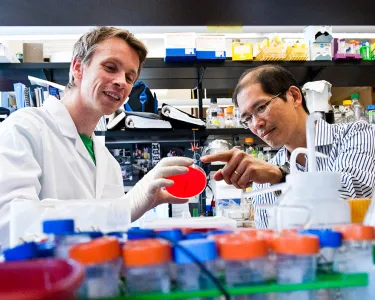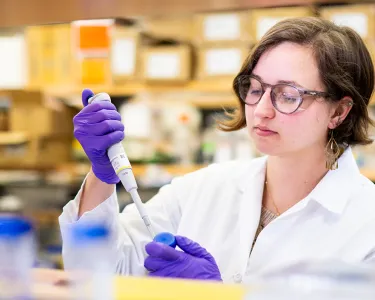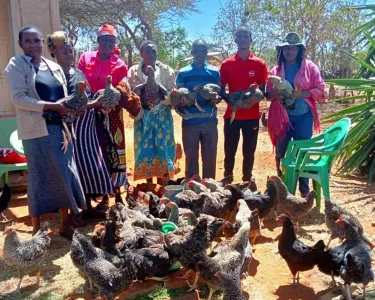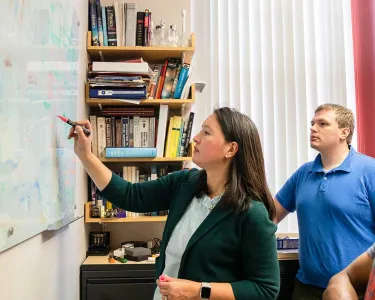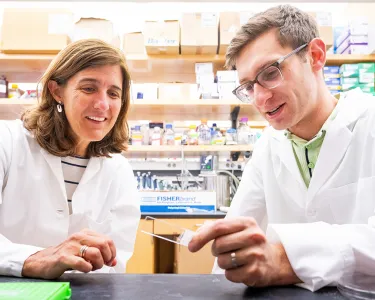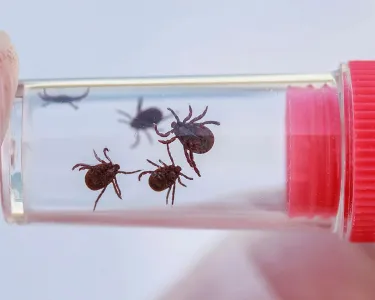Infection and Immunity
Tufts’ research into vaccines and immunity, contagious microorganisms, viral spillover and spread—and cutting-edge approaches to stopping infectious disease—is helping to make the world a safer place.
Protecting Humans, Animals, and the Planet from Disease

With devastating effects, infectious diseases easily spread around the globe and between animals and humans. Tufts has a long history of tackling infectious disease. For example, in the early 2000s, Cummings School of Veterinary Medicine researchers developed heat-stable vaccines that allowed for the eradication of rinderpest. That achievement represents only the second disease ever (after smallpox) to be officially declared eradicated—and the first-ever animal disease.
Today, Tufts researchers are, as ever, on the front lines in the fight against the spread of infection. That work includes: expanding knowledge about individual diseases and treatments; seeking ways to stop contagion, keeping livestock healthy (while also tackling gender inequality in the livestock keepers); uncovering solutions to the problem of antimicrobial resistance, and using data and technology to improve treatment and outcomes.
Among key Tufts initiatives in this field:
- The Stuart B. Levy Center for Integrated Management of Microbial Resistance, where university experts pull together stakeholders from across disciplines, professions, and government sectors to tackle the problem of antimicrobial resistance
- The New England Regional Biosafety Lab, housed at Cummings School of Veterinary Medicine and selected by the NIH as one of 12 such sites across the U.S., where Tufts scientists conduct in-depth investigations into avian influenza, COVID-19, tuberculosis, and other dangerous pathogens that require an ultrasafe setting for research
- STOP Spillover, a Tufts-led, USAID-funded global consortium of experts in human, animal, and environmental health. With a focus on understanding the risk factors that contribute to viral spillover from animals to humans, the consortium implements interventions to prevent zoonotic disease and assesses risk reduction practices and policies aimed at preventing spillover and mitigating the amplification and spread of disease.
- The Tufts Lyme Disease Initiative, which aims to eliminate Lyme disease as a growing human health threat by 2030. The first entity to identify Lyme disease, Tufts has been at the forefront of scientific advancement in tick-borne disease research since Lyme was first described in the U.S. in the 1970s. Tufts faculty have received millions of dollars in funding from the U.S. government, private foundations, and others to attack the disease from all angles—while also tackling other tick-borne diseases, including Powassan virus and babesiosis.
And we’re just getting started. Researchers across the university are leaning into the latest technologies to discover as-yet-unseen levels of infection fighting. From the Aldridge Lab at the School of Medicine, where researchers are using artificial intelligence to more quickly and effectively identify potential new drug cocktails to be used in the fight against tuberculosis, to the labs where scientists are developing mRNA- and antibody-based treatments to boost people’s immunity and increase our ability to wipe out infectious diseases, Tufts continues to confront infectious disease in pioneering new ways.
And importantly, throughout all such efforts, Tufts faculty are firmly dedicated to training the new infectious disease fighters and global health experts coming up, to carry this critical work even further in the next generation.
